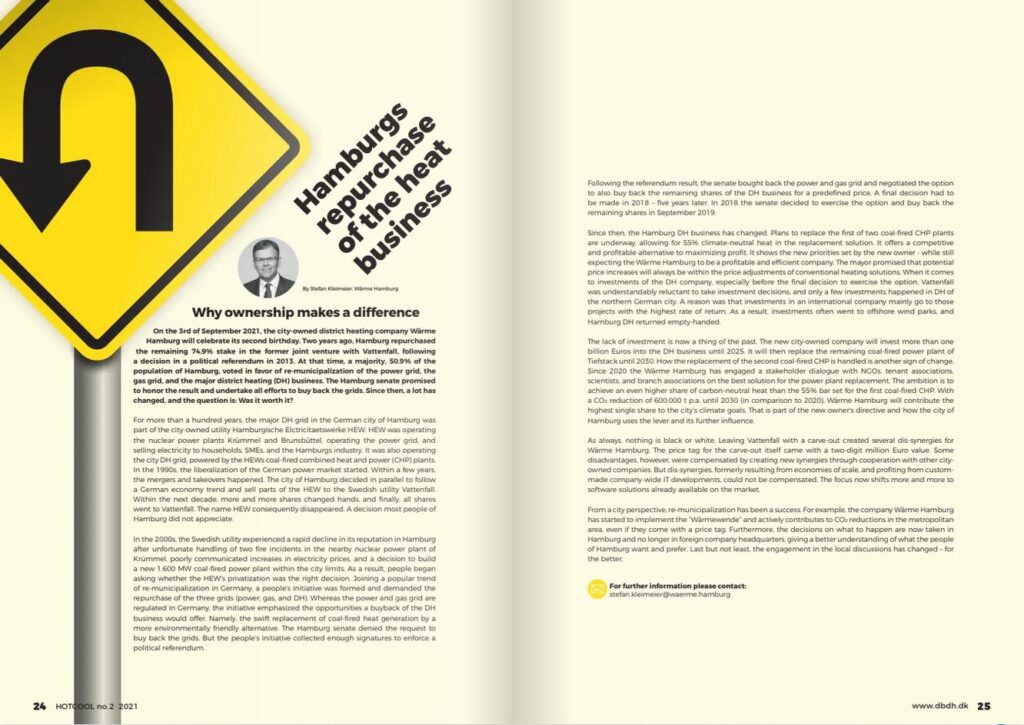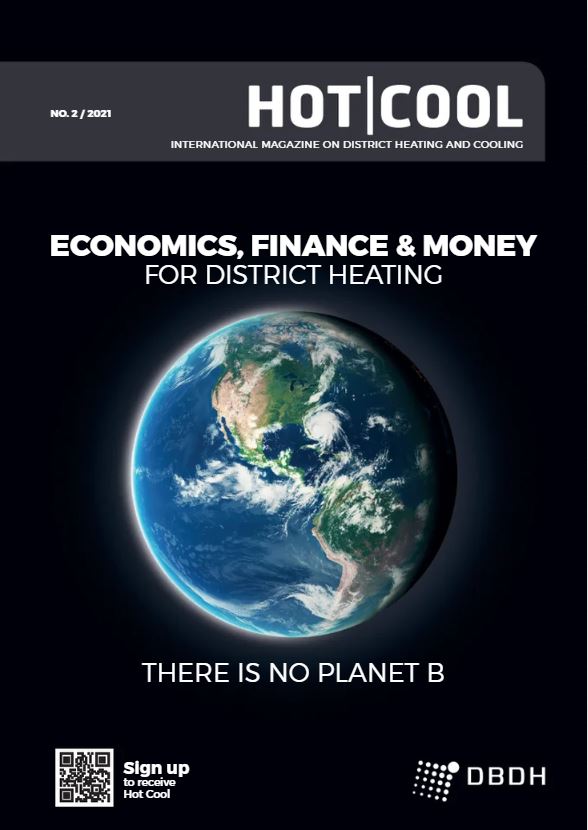Why ownership makes a difference
On the 3rd of September 2021, the city-owned district heating company Wärme Hamburg will celebrate its second birthday. Two years ago, Hamburg repurchased the remaining 74.9% stake in the former joint venture with Vattenfall following a decision in a political referendum in 2013. At that time, a majority, 50.9% of the population of Hamburg, voted in favor of re-municipalization of the power grid, the gas grid, and the major district heating (DH) business. The Hamburg senate promised to honor the result and undertake all efforts to buy back the grids.
Since then, a lot has changed, and the question is: Was it worth it?
By Stefan Kleimeier, Wärme Hamburg
For over a hundred years, the primary DH grid in the German city of Hamburg was part of the city-owned utility Hamburgische Elctricitaetswerke HEW. HEW was operating the nuclear power plants Krümmel and Brunsbüttel, operating the power grid, and selling electricity to households, SMEs, and the Hamburg industry. It also used the city DH grid, powered by the HEWs coal-fired combined heat and power (CHP) plants.
In the 1990s, the liberalization of the German power market started. Within a few years, the mergers and takeovers happened. The city of Hamburg decided in parallel to follow a German economic trend and sell parts of the HEW to the Swedish utility Vattenfall.
Within the next decade, more and more shares changed hands, and finally, all shares went to Vattenfall. The name HEW consequently disappeared. A decision most people of Hamburg did not appreciate.
In the 2000s, the Swedish utility experienced a rapid decline in its reputation in Hamburg after the unfortunate handling of two fire incidents in the nearby nuclear power plant of Krümmel, poorly communicated increases in electricity prices, and a decision to build a new 1,600 MW coal-fired power plant within the city limits.
As a result, people began asking whether the HEW’s privatization was the right decision. Joining a popular trend of re-municipalization in Germany, a people’s initiative was formed and demanded the repurchase of the three grids (power, gas, and DH). Whereas the power and gas grids are regulated in Germany, the initiative emphasized the opportunities a buyback of the DH business would offer—namely, the swift replacement of coal-fired heat generation by a more environmentally friendly alternative. The Hamburg senate denied the request to buy back the grids. However, the people’s initiative collected enough signatures to enforce a political referendum.
Following the referendum result, the senate bought back the power and gas grid and negotiated the option to buy back the remaining shares of the DH business for a predefined price. A final decision had to be made in 2018 – five years later. In 2018, the Senate decided to exercise the option and buy back the remaining shares in September 2019.
Since then, the Hamburg DH business has changed. Plans to replace the first two coal-fired CHP plants are underway, allowing for 55% climate-neutral heat in the replacement solution. It offers a competitive and profitable alternative to maximizing profit. It shows the new priorities set by the new owner – while still expecting Wärme Hamburg to be a profitable and efficient company. The mayor promised that potential price increases would always be within the price adjustments of conventional heating solutions.
Regarding investments of the DH company, especially before the final decision to exercise the option, Vattenfall was understandably reluctant to make investment decisions, and only a few investments happened in DH of
the northern German city. One reason was that investments in an international company mainly go to those projects with the highest rate of return. As a result, investments often went to offshore wind parks, and Hamburg DH returned empty-handed.
The lack of investment is now a thing of the past. The new city-owned company will invest over one billion Euros into the DH business until 2025. It will then replace the remaining coal-fired power plant of Tiefstack until 2030. How the replacement of the second coal-fired CHP is handled is another sign of change.
Since 2020, the Wärme Hamburg has engaged in a stakeholder dialogue with NGOs, tenant associations, scientists, and branch associations on the best solution for the power plant replacement. The ambition is to achieve an even higher share of carbon-neutral heat than the 55% bar set for the first coal-fired CHP. With a CO2 reduction of 600,000 t p.a. until 2030 (in comparison to 2020), Wärme Hamburg will contribute the highest single share to the city’s climate goals. That is part of the new owner’s directive and how the city of Hamburg uses the lever and its further influence.
As always, nothing is black or white. Leaving Vattenfall with a carve-out created several dis-synergies for Wärme Hamburg. The price tag for the carve-out itself came with a two-digit million Euro value. Some disadvantages, however, were compensated by creating new synergies through cooperation with other city-owned companies. But dis-synergies, formerly resulting from economies of scale and profiting from custom-made company-wide IT developments, could not be compensated. The focus now shifts more and more to software solutions already available on the market.
From a city perspective, re-municipalization has been a success. For example, the company Wärme Hamburg has started implementing the “Wärmewende” and actively contributes to CO2 reductions in the metropolitan area, even if it comes with a price tag. Furthermore, the decisions on what to happen are now taken in Hamburg and no longer in foreign company headquarters, giving a better understanding of what the people of Hamburg want and prefer. Last but not least, the engagement in the local discussions has changed – for the better.
For further information, please contact: Stefan Kleimeier, stefan.kleimeier@waerme.hamburg


